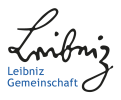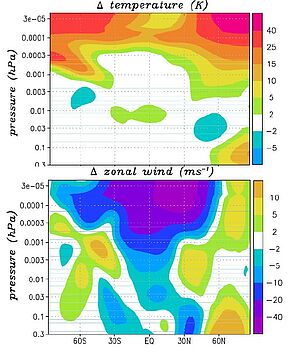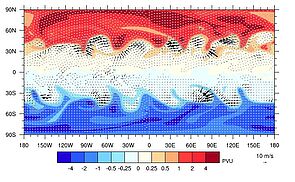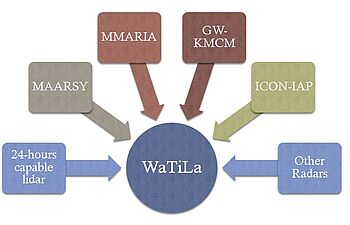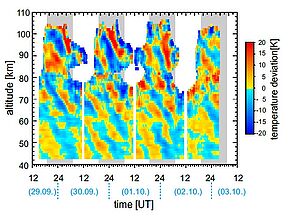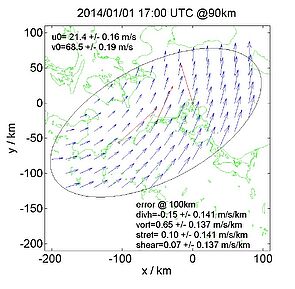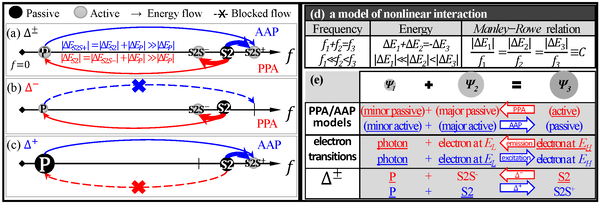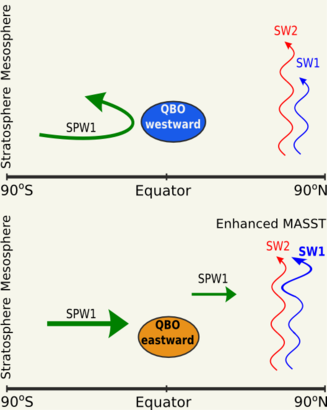WATILA Project
Interactions of Waves and Tides at Mid and High Latitudes in the Ignorosphere (WaTiLa)
J. L. Chau, F. J. Lübken, E. Becker
Summary
The general circulation and thermal structure of the middle atmosphere crucially depends on waves such as planetary waves, tides, and gravity waves. However, the morphology of these waves and their interaction with each other is only poorly understood. We intend to study these waves focusing on tides. Short-term variability (days to weeks) is studied using standard as well as unique radar and lidar instruments in combination with global satellite observations. To understand the physics and impact of tides we use state-of-the-art models, e.g., a gravity wave resolving model including tides, and a regional model.
Specific questions
- What are the mean amplitudes and short-term variability of tides and their observed correlations with SPWs, PWs and GWs in the MLT at mid and high latitudes?
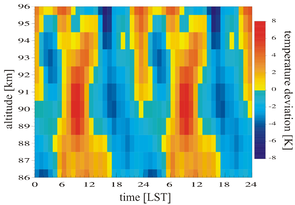
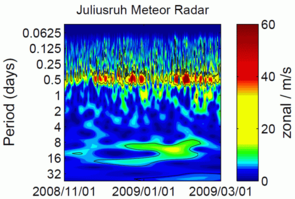
- How do wave-wave and wave-mean flow interactions give rise to the observed tidal mean amplitudes and variations at mid and high latitudes?
List of participants
- Prof. Dr. F.-J. Lübken
- Prof. Dr. J. L. Chau
- Prof. Dr. E. Becker
- Dr. G. Stober
- Dr. M. He
- Dr. F. I. Laskar
- S. Wilhelm
- N. Gudadze
Preliminary results
Nonlinear interaction between planetary waves and the solar semidiurnal tide
Nonlinear interaction is a prototypical behavior of waves, as fundamental as Doppler shift, interference, and diffraction. Nonlinear interactions between atmospheric planetary scale waves have been reported in numerous studies. In the current work, we apply for the first time Manley-Rowe relations to determine the energy flow in the atmospheric interactions, and roles of the interacting waves.
Particularly, we report and analyze a textbook case of nonlinear interactions between planetary waves (PWs) and the migrating solar semidiurnal tide. Our analysis suggests that the secondary waves, well known as zonal wave-1 and wave-3 enhancements, are fed on the energy mainly from the tide. Although the energy flow through PWs is relatively negligible, our investigations suggest that the energy budget of PWs might act as a key in turning on/off the interactions.
When PWs accept energy in the interaction, the wave-1 is generated, whereas when PWs export energy, the wave-3 is generated. In the combined case, PWs could accept energy from the tide and meanwhile export energy to wave-3, generating both wave-1 and wave-3. The energy transport from the tide to PWs in generating wave-1 might supply the secondary PW in the late SSW stage reported in previous studies.
For details, cf He et al., (2017), Application of Manley-Rowe relation in analyzing nonlinear interactions between planetary waves and the solar semidiurnal tide during 2009 Sudden Stratospheric Warming event, J. Geophys. Res., 122, doi:10.1002/2017JA024630.
Two topologies (AAP and PPA) of energy flow of the nonlinear interactions inside the triads ∆_i^± :=( P_i , S2, S2S_i^± ), according to MRRs based on the assumption that all sidebands S2Ss are energy acceptors in the interactions. AAP represents in the interacting modes are active, active and passive modes in the order from low to high frequency respectively. PPA represents the interacting modes are passive, passive and active modes, in the order.
- (a-c) The topologies in frequency space for three possibilities of the asynchrony/synchrony between ∆ _i^- and ∆ _i^+.
- (d) MRRs, namely frequency and energy relations, for a typical nonlinear interactions among three waves with frequency relations f1<<f2<f3.
- (e) energy flows in AAP and PPA models, and in two sets of instances, namely electron transitions and ∆^± interactions.
Throughout the current paper, the blue elements represent the AAP topology whereas the red elements represent PPA. The arrows indicate the energy flow, whose thickness sketches the amount of exchanged energy.
QBO Modulation of Northern Middle and High-latitude Semi-diurnal Tides
Semidiurnal Tidal amplitudes derived from meteor radar winds over Andenes (69°N,16°E) and Juliusruh (54°N,13°E) show increased amplitudes during August-September. Over and above these enhanced amplitudes it has been observed that these amplitudes show a systematic relationship with the Quasi-Biennial Oscillations (QBO) in winds over the low-latitudes. This kind of teleconnection between low-latitude QBO and mid- and high-latitude tides can have three probable explains: 1) Tidal source (ozone and water-vapour) changes associated to QBO phases, 2) Propagation/dissipation condition changes over the stations due to QBO wind, and 3) interaction with other waves that are modulated by QBO. We have investigated the above three possibilities and proposed that the third process is most plausible to explain the observed QBO modulation of tides in the middle and high-latitude MLT regions. The mechanism has been illustrated with a schematic in Figure 1. Where we speculate that the enhanced quasi-stationary planetary waves (SPWs) from the winter hemisphere reached summer hemisphere after being modulated by QBO winds over the equator. Thereafter these enhanced SPWs interact with the SW1 to imprint the signature of QBO on semi-diurnal tides. More details about these could be found in Laskar et al., [2016].
Local Dynamics Over Polar Latitudes Using Multi-Station Meteor Radars
Combined meteor detections from two existing meteor radars at Andenes (69°N,16°E) and Tromso (70°N,19°E) were used to derive the gradients, divergence, and vertical vorticity. These wind field informations could be used for the investigation of the local dynamics. For example, the horizontal divergence measured from this experimental setup has been used recently to derive the summer mean vertical velocity. The experimental determination of the vertical velocity is a challenging task as they are of very small magnitudes to measure with significant accuracy. The vertical velocity has been derived from the horizontal divergence using three dimensional mass continuity equation, where Fe-lidar temperatures have been used to calculate the density scale height. The resulting vertical velocity profiles with different boundary conditions for all the years of observation using the 2015 lidar temperature as representative are shown in Figure 2. The importance of the vertical velocity is that they are required for the estimation of wave driven momentum flux, which are very important for the understanding of the middle atmospheric dynamics. Further details about these could be found in Chau et al., [2017] and Laskar et al., [2017].
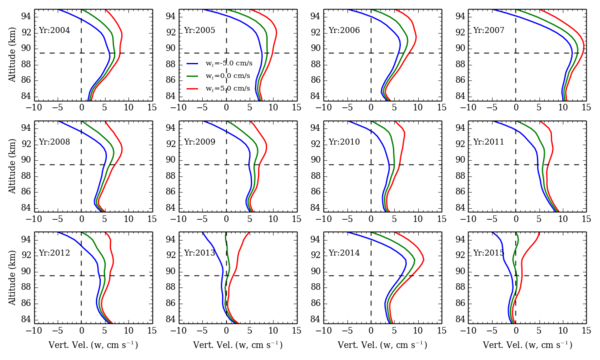
continuity equation using various boundary values (wt) at the top has been shown for all the years of
observation. It could be seen that in almost all the years the w values have a maximum at around the
mesopause altitude, suggesting that there occurs maximum adiabatic cooling due to upwelling.
References
- F. I. Laskar, J. L. Chau, J. P. St-Maurice, G. Stober, C. M. Hall, M. Tsutsumi, J. Höffner and P. Hoffmann, Experimental evidence of arctic summer mesospheric upwelling and its connection to cold summer mesopause, Geophys. Res. Lett., doi:10.1002/2016RS006225, 2017.
- J. L. Chau, G. Stober, C. M. Hall, M. Tsutsumi, F. I. Laskar and P. Hoffmann, Polar mesospheric horizontal divergence and relative vorticity measurements using multiple specular meteor radars, Radio Sci., 52, 811-828, doi:10.1002/2016RS006225, 2017.
- F. I. Laskar, J. L. Chau, G. Stober, P. Hoffmann, C. M. Hall and M. Tsutsumi, Quasi biennial oscillation modulation of the middle- and high-latitude mesospheric semidiurnal tides during August - September, J. Geophys. Res., 121, 4869-4879, doi:10.1002/2015JA022065, 2016.
- He, M., J. L. Chau, G. Stober, G. Li, B. Ning, P. Hoffmann, Diagnosing the zonal wavenumber of tidal variants with a limited number of ground-based detectors through a phase differencing technique, Geophy. Rese. Lett., submitted, 2017.
- He, M., J. L. Chau, G. Stober, C. M. Hall, M. Tsutsumi, and P. Hoffmann, Application of Manley-Rowe 1 relation in analyzing nonlinear interactions between planetary waves and the solar semidiurnal tide during 2009 Sudden Stratospheric Warming event, J. Geophys. Res., doi: 10.1002/2017JA024630, 2017.
- Stober, G., V. Matthias, C. Jacobi, S. Wilhelm, J. Höffner, and J. L. Chau, Exceptionally strong summer-like zonal wind reversal in the upper mesosphere during winter 2015/16, Ann. Geophys., 35, 711-720, doi:10.5194/angeo-35-711-2017, 2017.
- Chau, J. L. and J. P. St. Maurice, Unusual 5-m E region observed at mid-latitudes during the March 17, 2015 storm with the use of multi-static, multi-frequency VHF radar links, J. Geophys. Res., doi:10.1002/2016JA023104, 2016.
- Wilhelm, S., G. Stober, and J. L. Chau, A comparison of 11 year mesospheric and lower thermospheric winds determined by meteor and MF radar at 69 N, Ann. Geophys., 35, 893-906, doi: 10.5194/angeo-35-893-2017, 2017.
- St. Maurice, J. P. and J. L. Chau, A theoretical framework for the changing spectral properties of meter-scale Farley-Buneman waves between 90 and 125 km altitudes, J. Geophys. Res., doi:10.1002/2016JA023105, 2016.
- E. Becker, Mean-flow effects of thermal tides in the mesosphere and lower thermosphere, J. Atmos. Sci., 74, 2043-2063, doi:10.1175/JAS-D-16-0194.1, 2017.

